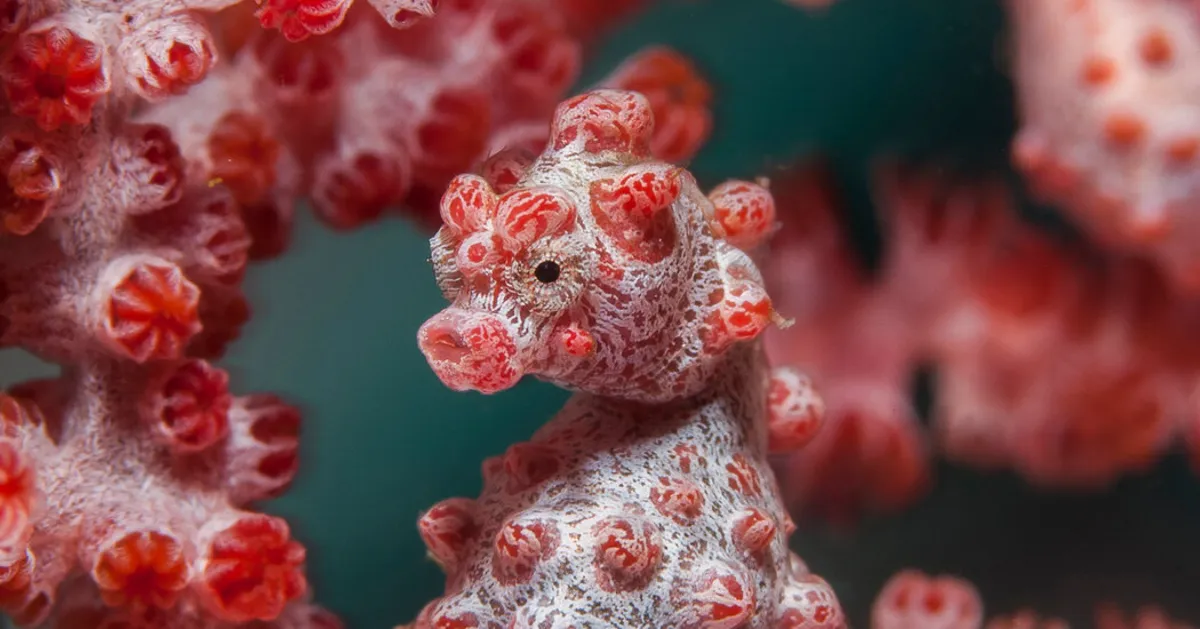
The pygmy sea horse, a remarkable one-inch-long fish, inhabits the vibrant corals of the Pacific Ocean. These corals, characterized by their fan-shaped and knobby structures, are venomous; however, the pygmy sea horse has developed a unique ability to navigate this dangerous environment. By skillfully wrapping its tail around the branches of the coral, the sea horse can safely feed on microscopic animals that drift by, showcasing its extraordinary adaptation to life among these hazardous corals.
One of the most striking features of the pygmy sea horse is its ability to blend seamlessly into its surroundings. Some species exhibit a pink hue, while others are bright yellow, allowing them to match the specific type of coral they inhabit. In addition to their coloration, pygmy sea horses possess body knobs that mimic the size and spacing of the coral’s knobs. This incredible camouflage protects them from potential predators, making them nearly invisible against the backdrop of their coral home. Interestingly, the pygmy sea horse has a face reminiscent of a pug, with a snout that resembles another coral knob, enhancing its ability to evade detection.
In a remarkable twist on traditional reproductive roles, the pygmy sea horse flips the script on gender roles. After mating, the female deposits fertilized eggs into the male’s body, where he carries the embryos. While male pregnancy is a common trait among sea horses, the pygmy sea horse takes this to an extraordinary level. Rather than a simple pouch, the male has a brood pouch that functions like a uterus, residing deep within his body cavity. This pouch nurtures the developing young with a specialized organ that acts similarly to a mammalian placenta. Once the baby sea horses hatch, they emerge from their father's body through a tiny slit, ready to explore their aquatic world.
The evolutionary journey of the pygmy sea horse has intrigued scientists, prompting a collaborative study between Chinese and German researchers who sequenced the genome of this extraordinary creature for the first time. “They’re just something very odd and interesting and in need of explanation,” remarked Axel Meyer, an evolutionary biologist at the University of Konstanz in Germany and an author of the study published in the Proceedings of the National Academy of Sciences.
The research revealed that some mutations in the pygmy sea horse's DNA altered single genetic letters, leading to subtle changes in protein shapes, particularly those involved in the nervous system. These changes likely enabled the pygmy sea horse to develop immunity to the venom that typically affects other species, allowing it to thrive in a venomous environment.
Evolution is an intricate process, and in the case of the pygmy sea horse, some of the most fascinating developments stem from the loss of certain genes. The researchers found that pygmy sea horses had lost 438 entire genes found in other sea horse species. Additionally, another 635 genes were rendered inactive, and approximately 5,135 genes lost regulatory switches, resulting in a unique evolutionary outcome. These genetic losses impacted the development of the pygmy sea horse’s head, leading to its distinctive knob-like snout rather than a traditional horse-like appearance.
Despite the significant loss of genes in their immune system, pygmy sea horses do not appear to be more susceptible to diseases. This resilience may be attributed to the corals themselves, which produce a variety of antibiotics and protective molecules. These compounds not only safeguard the corals but may also provide a protective benefit to the pygmy sea horses that inhabit them.
The loss of immune genes may have opened new pathways for evolution in the pygmy sea horse. For example, it might explain their unique form of male pregnancy, as the deep internal brooding could trigger the immune system to react to the embryos as foreign tissue. By losing certain immune genes, males may have evolved the ability to tolerate their young without immune rejection. Cristian Cañestro, a geneticist at the University of Barcelona, emphasized that “gene losses are pervasive in all branches of the tree of life,” and noted that the pygmy sea horse exemplifies how the loss of genes can lead to beneficial evolutionary innovations and adaptations.
The pygmy sea horse is not just a marvel of nature due to its size and appearance; it also represents a fascinating case study in evolutionary biology. Through its unique adaptations, reproductive roles, and genetic changes, this tiny fish offers profound insights into the complexities of evolution and the incredible diversity of life in our oceans.